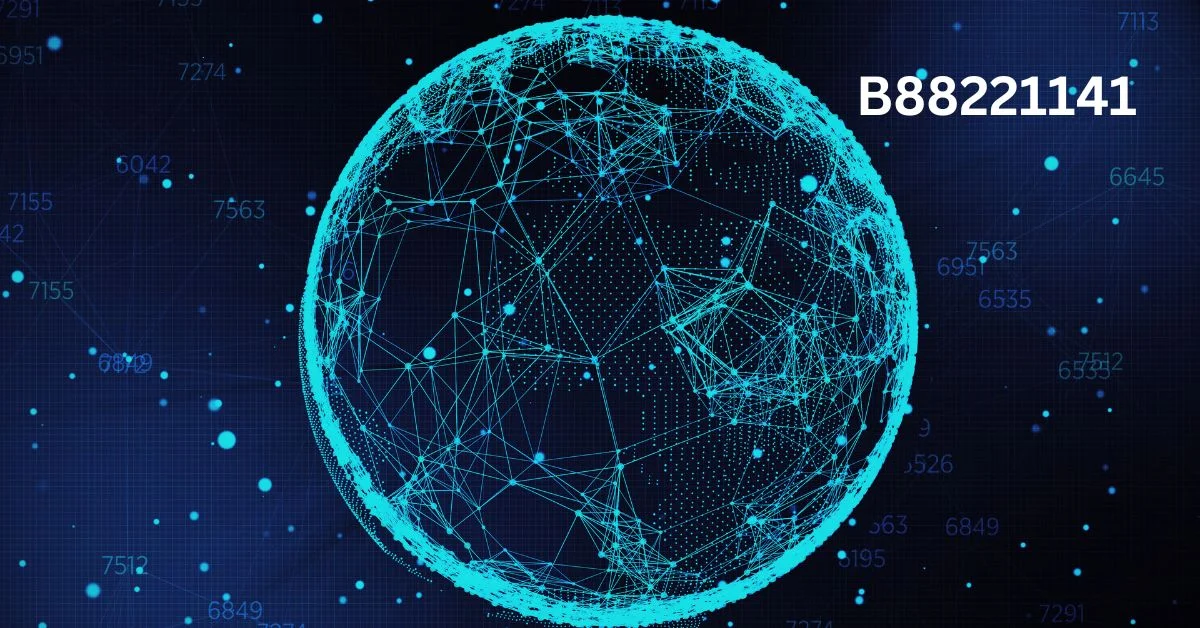In the vast world of technology, certain alphanumeric codes stand out, becoming integral to specific industries, applications, and even cultures within the tech ecosystem. One such code is B88221141, a unique identifier that has recently captured attention across various online forums and technical communities. To many, it might appear as just another random combination of letters and numbers, but this code holds deeper significance, often tied to systems, tools, and frameworks within the tech space. This article explores the mysteries behind B88221141, its origins, uses, connections to significant historical figures, and much more.
What is B88221141?
At its core, B88221141 is a complex alphanumeric string that represents a unique identifier or tool used in modern technological processes. While it may be tempting to treat it as an arbitrary number, in reality, it stands for something much more significant. Codes like B88221141 are designed to identify or label components within the rapidly evolving digital landscape.
The exact definition or function of B88221141 varies depending on its context. It may represent a software version, a unique dataset, a digital tool, or even an identifier used in machine learning algorithms or AI-driven systems. It is a key component of modern digital ecosystems, where such identifiers are increasingly crucial for managing, categorizing, and processing data.
The Origins and Evolution of B88221141
The history of B88221141 can be traced back to the rise of the need for unique identifiers in the tech world. In an increasingly digital and data-driven environment, the need to distinguish between different systems, products, or components has grown substantially. Just like other alphanumeric codes used in software development, product cataloging, and data analytics, B88221141 was created to streamline and optimize processes.
The code is part of a broader movement within the tech industry, where digital transformation has pushed organizations to refine workflows, enhance efficiencies, and improve productivity. As the digital ecosystem expanded, identifiers like B88221141 became vital for creating order in a world filled with vast quantities of data and complex systems. This evolution is deeply tied to the increasing reliance on AI, machine learning, and data management solutions, where such codes serve as markers for various entities and systems.
Key Features and Benefits of B88221141
To fully understand the significance of B88221141, it’s essential to examine its features and benefits in the context of modern technology. Here are some key features that make this code important:
- Unique Identification: Just like a product code, B88221141 is used to uniquely identify components, datasets, or tools. In a digital ecosystem where billions of data points and system components are being tracked, a unique identifier ensures that each entity can be easily distinguished from others.
- Data Management: As businesses and organizations become more data-driven, the need for effective data management grows. B88221141 plays a crucial role in ensuring that data is categorized, processed, and tracked efficiently. With its use, data operations can be streamlined, making it easier to organize and analyze complex datasets.
- Integration Across Platforms: The versatility of B88221141 enables it to be used across various platforms, systems, and industries. Whether it’s in machine learning models, AI frameworks, or software development projects, the code is adaptable and facilitates smooth integration across diverse technologies.
- Enhanced Efficiency: The growing complexity of digital workflows means that organizations need systems in place that optimize productivity. B88221141 helps to improve operational efficiency by simplifying identification processes and reducing manual tasks that would otherwise slow down project timelines.
- Cross-Industry Application: While B88221141 is widely used in software development and data analytics, its applications can extend beyond just these fields. In sectors like finance, healthcare, and manufacturing, codes like B88221141 help streamline operations, automate tasks, and create seamless integrations between various tools.
The Role of B88221141 in AI and Machine Learning
The impact of B88221141 is particularly evident in fields like artificial intelligence (AI) and machine learning. These areas rely heavily on datasets and the ability to track, process, and identify components within vast arrays of information. B88221141 can serve as a unique identifier for datasets, models, or tools within these fields.
In machine learning, for instance, a dataset labeled with B88221141 can be easily distinguished from other datasets, helping developers and analysts track performance, build models, and optimize algorithms more effectively. Similarly, in AI, the code might be used to label components of a system, such as algorithms, neural networks, or training data, ensuring that each element is easily accessible and identifiable.
The Link to Historical Codes: The Enigma Code and Machine
While B88221141 is a product of modern technology, it shares similarities with one of the most famous codes in history—the Enigma code. The Enigma machine, invented in the early 20th century, played a significant role during World War II. It was used by the German military to encrypt messages, making it incredibly difficult for Allied forces to decipher their communications.
The Enigma machine used a complex cipher system that required advanced mathematical skills and pattern recognition to crack. The code was eventually broken by a team of cryptanalysts, led by Alan Turing, in what has been described as one of the most important breakthroughs in cryptography and wartime intelligence.
Who broke the Enigma code first?
The person who is most famously associated with breaking the Enigma code is Alan Turing. His work at Bletchley Park, alongside other cryptanalysts, led to the successful decryption of the Enigma cipher, a breakthrough that was crucial to the Allied victory in World War II.
The Enigma machine was a key tool used by Nazi Germany for encryption during the war. It allowed for highly secure military communications, making it a formidable challenge for the Allies. However, after significant effort and innovation, Turing and his team succeeded in developing a machine that could decipher the encrypted messages, drastically shortening the war and saving countless lives.
The Enigma Cipher and Its Modern Relevance
The Enigma cipher, once considered unbreakable, is now viewed as a historical curiosity and a fascinating example of cryptography. The modern equivalent of the Enigma code can be seen in complex encryption systems used to secure digital communications. Much like the Enigma machine of the past, today’s cryptographic methods protect sensitive information across industries, from finance to healthcare.
While the Enigma cipher was eventually broken, its influence on the field of cryptography remains strong. The lessons learned from decrypting the Enigma code continue to shape how we think about security in the digital age, emphasizing the importance of robust encryption systems and the ongoing battle between codebreakers and those who seek to secure their communications.
Enigma in Popular Culture: From Games to Films
The Enigma machine and its code-breaking history have also been immortalized in popular culture, through works such as the Enigma game, The Enigma code film, and the portrayal of Turing’s life and contributions. These adaptations provide insight into the pivotal role the Enigma machine played in shaping history.
Enigma game
Various games, including puzzle and strategy-based games, have drawn inspiration from the Enigma machine. Players often engage in codebreaking or cryptographic challenges that mimic the complexities of deciphering encrypted messages, just like Turing and his team did.
Enigma code film
One of the most notable films about the Enigma code is The Imitation Game, which portrays Alan Turing’s work and the efforts of his team to break the Enigma cipher. The film brings attention to Turing’s pivotal role in history, and it shines a light on the challenges faced by cryptanalysts during wartime.
Conclusion
The alphanumeric code B88221141, while mysterious at first glance, has important implications in modern technology, particularly in the realms of data management, machine learning, and AI. Its origins and evolution reveal a deep connection to the growing need for effective digital tools and identifiers that streamline processes, integrate systems, and optimize workflows.
Much like the famous Enigma machine and its code, which became synonymous with codebreaking and cryptography, B88221141 exemplifies the ways in which modern technology continues to shape the world around us. By understanding codes like B88221141, we can better appreciate the complexities and intricacies of digital systems that power today’s advanced technological landscape.
Frequently Asked Questions (FAQs)
1. What is B88221141?
B88221141 is an alphanumeric code used as a unique identifier in various tech systems, helping to streamline data management and digital operations.
2. Who invented the Enigma machine?
The Enigma machine was invented by the German engineer Hans Christian Oskar Scherbius in 1918. It was later adopted by the German military during World War II.
3. How did Alan Turing break the Enigma code?
Alan Turing and his team at Bletchley Park developed a machine that could decode messages encrypted by the Enigma machine, using mathematical algorithms and pattern recognition.
4. What is the Enigma cipher?
The Enigma cipher is the encryption system used by the German military during World War II, which employed the Enigma machine to encrypt communications.
5. Is there a game based on the Enigma code?
Yes, several games, including puzzle games, are based on the concept of codebreaking, where players attempt to crack encrypted messages similar to how the Enigma code was deciphered.
6. What was the significance of breaking the Enigma code in World War II?
Breaking the Enigma code was a pivotal moment in World War II, as it allowed the Allies to intercept and decode German military communications, ultimately contributing to their victory.








